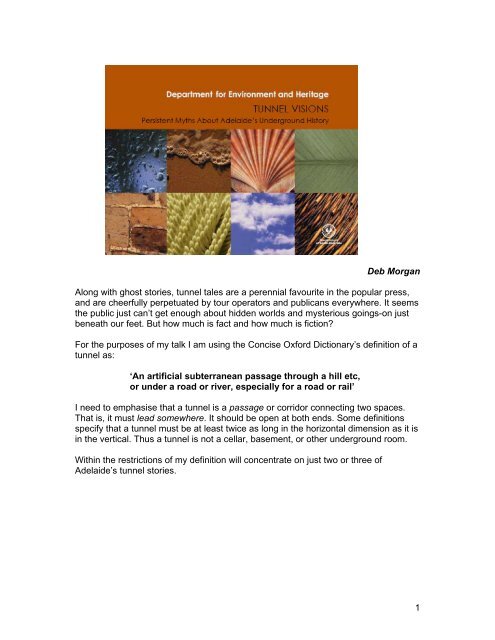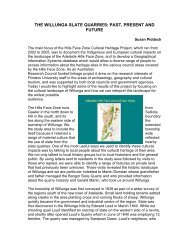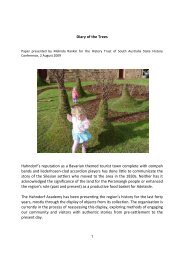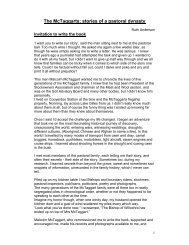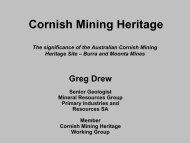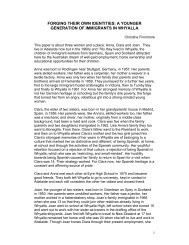1 Deb Morgan Along with ghost stories, tunnel tales are ... - History SA
1 Deb Morgan Along with ghost stories, tunnel tales are ... - History SA
1 Deb Morgan Along with ghost stories, tunnel tales are ... - History SA
You also want an ePaper? Increase the reach of your titles
YUMPU automatically turns print PDFs into web optimized ePapers that Google loves.
<strong>Deb</strong> <strong>Morgan</strong><br />
<strong>Along</strong> <strong>with</strong> <strong>ghost</strong> <strong>stories</strong>, <strong>tunnel</strong> <strong>tales</strong> <strong>are</strong> a perennial favourite in the popular press,<br />
and <strong>are</strong> cheerfully perpetuated by tour operators and publicans everywhere. It seems<br />
the public just can’t get enough about hidden worlds and mysterious goings-on just<br />
beneath our feet. But how much is fact and how much is fiction?<br />
For the purposes of my talk I am using the Concise Oxford Dictionary’s definition of a<br />
<strong>tunnel</strong> as:<br />
‘An artificial subterranean passage through a hill etc,<br />
or under a road or river, especially for a road or rail’<br />
I need to emphasise that a <strong>tunnel</strong> is a passage or corridor connecting two spaces.<br />
That is, it must lead somewhere. It should be open at both ends. Some definitions<br />
specify that a <strong>tunnel</strong> must be at least twice as long in the horizontal dimension as it is<br />
in the vertical. Thus a <strong>tunnel</strong> is not a cellar, basement, or other underground room.<br />
Within the restrictions of my definition will concentrate on just two or three of<br />
Adelaide’s <strong>tunnel</strong> <strong>stories</strong>.<br />
1
King William Road Tunnel<br />
Elder Park viewed from North Adelaide. The cutting for the King William Road <strong>tunnel</strong> can be seen in<br />
the centre of the picture, as the rail line goes under the road at the extreme left. This photo is undated<br />
but possibly early 1900s. (Photo courtesy of the National Railway Museum, Port Adelaide <strong>SA</strong>)<br />
Probably most Adelaidians would have heard about a <strong>tunnel</strong> running under King<br />
William Road. A number of different <strong>stories</strong> seem to converge on this particular<br />
<strong>tunnel</strong>. The versions I have come across include:<br />
• That there was a <strong>tunnel</strong> running from Government House to Parliament<br />
House, to facilitate secret meetings between Parliamentarians and the<br />
Governor;<br />
• That there was a private underground passage linking Parliament House and<br />
the Adelaide Railway station so MPs could catch their trains <strong>with</strong>out having to<br />
brave the weather;<br />
• That a <strong>tunnel</strong> extended underground beneath North Terrace, all the way to<br />
Pulteney Street, or even as far as Frome Road;<br />
• That an underground railway branch line ran through the <strong>tunnel</strong>; and<br />
• that it incorporated one or more underground station platforms, and was used<br />
to deliver goods to various North Terrace businesses via a network of<br />
connecting <strong>tunnel</strong>s.<br />
Well, there was definitely a <strong>tunnel</strong> under King William Road. Indeed, it’s still there,<br />
though filled in <strong>with</strong> rubble. It runs diagonally under the road, between where the<br />
Festival Centre now stands and just north of the boundary of the Government House<br />
Domain.<br />
It is my suspicion that this rather modest little <strong>tunnel</strong> has given rise to most, if not all,<br />
of the <strong>stories</strong> I just mentioned.<br />
I might mention at this point that I have referred to the work of P J Barry and George<br />
Daws for much of my information on the King William Road Tunnel.<br />
2
The <strong>tunnel</strong> was ‘rediscovered’ in 1973, around the time of the opening of the new<br />
Festival Centre. As part of this development, reconstruction work was taking place on<br />
King William Road. It was known from the old Adelaide City Council records that<br />
there had once been a <strong>tunnel</strong> under the road, through which a railway spur line to the<br />
old Exhibition Grounds used to pass. The opportunity was taken to expose the <strong>tunnel</strong><br />
to see whether it would be worthwhile restoring it as a pedestrian sub-way. A section<br />
of the <strong>tunnel</strong> was excavated, revealing a bluestone-lined <strong>tunnel</strong> 15 feet wide and at<br />
least 30 feet long. The Council thought that, restored to its original appearance, the<br />
<strong>tunnel</strong> would make a grand addition and counterpoint to the modern architectural<br />
form of the new Festival Centre precinct, whilst allowing Festival patrons to cross the<br />
road in safety. And it would be a tourist attraction. The State Government agreed to<br />
contribute towards the estimated $35,000 cost of the project, plans were drawn up,<br />
and tenders called.<br />
Alas, it turned out that the initial estimates were grossly inadequate, and <strong>with</strong> the<br />
projected costs escalating to $90,000 or possibly $140,000 for complete restoration,<br />
the project was abandoned. The test excavations were refilled <strong>with</strong> quarry rubble,<br />
and sealed <strong>with</strong> a temporary surface coat.<br />
The <strong>tunnel</strong> has an interesting history: It dates back to the very early days of the<br />
colony, well before the railway. This type of underpass was known as a ‘cattle<br />
creep’, or ‘cattle arch’, and this gives a clue to its function as a means of permitting<br />
grazing livestock to cross from paddocks either side of the road, <strong>with</strong>out obstructing<br />
traffic or straying.<br />
From around 1850 a detachment of the Royal Sappers and Miners, engaged on<br />
survey work, was housed in cottages on the site of the present Parade Ground, and<br />
3
their horses were stabled on the open ground to the west. Horses belonging to the<br />
South Australian Mounted Police, based on North Terrace, were also kept here, and<br />
it became known as the Police Paddock.<br />
When King William Street was extended through the Government Domain in the mid<br />
1850s, and the first City Bridge was constructed across the Torrens, the barracks<br />
were effectively cut off from the stables and paddocks on the other side of the road.<br />
The bridge had to be built high enough to escape the floods, which periodically cut off<br />
North Adelaide from the city proper, and this meant substantial earthworks were<br />
needed to raise the level of the road on the southern approach. The steep<br />
embankment thus created was an obstacle, which was dealt <strong>with</strong> by including in the<br />
plans ‘a small bridgeway …to admit of communication <strong>with</strong> the police paddock’ (this<br />
is quoted from a report prep<strong>are</strong>d for the Legislative Council by William Bennett Hays,<br />
Colonial Architect and Supervisor of Works).<br />
It seems highly likely that the ‘bridgeway’ referred to is the <strong>tunnel</strong> that exists today,<br />
and that it was built as part of the construction works for the new road. An alternative<br />
theory is that the need for the <strong>tunnel</strong> only became app<strong>are</strong>nt after the road was<br />
completed, and that it was constructed by the Sappers and Miners.<br />
However given the above evidence it is much more probable that the underpass was<br />
constructed at the same time, and by the same government contractors engaged to<br />
carry out the roadworks. Work commenced on the embankment in December 1854,<br />
and the South Australian Register of 1 June 1855 reported that the roadway linking<br />
King William Street to the new bridge was complete and open to traffic.<br />
View across North Parklands looking south-east towards King William Road. Government House in upper right<br />
corner. (Illustrated Sydney News July 1876 (reproduced in Heritage of the City of Adelaide)<br />
This detail taken from a view of Adelaide published in the Illustrated Sydney News in<br />
July 1876 clearly shows the western opening of the <strong>tunnel</strong> through the embankment<br />
leading down to the iron bridge over the Torrens.<br />
4
In 1886 the <strong>tunnel</strong> was deepened and underpinned to accommodate a railway<br />
branch line connecting the Exhibition Grounds <strong>with</strong> Adelaide Railway Station in<br />
preparation for the Jubilee International Exhibition of the following year.<br />
1919 map showing route of the Jubilee Railway branch line (also known as the Exhibition line). Adelaide City<br />
Archives<br />
The line ran eastwards from the north side of the station, via a shallow cutting<br />
alongside the City Baths, under King William Road and along the southern side of the<br />
Torrens Parade Ground. From there it ran parallel to the river before veering south,<br />
passing through the British Machinery Hall and terminating inside the northern<br />
annexe of the Exhibition Building on the western side of Frome Road. It was used for<br />
transporting exhibits of heavy machinery and other goods to the grounds. These<br />
included a locomotive and tender, built in Ballarat, which were installed at the end of<br />
the track on 20 May 1887, so it can be assumed the line would have been opened<br />
shortly before that date.<br />
The Jubilee Exhibition ran until January 1888, after which the line continued in use,<br />
providing access to the Exhibition Building and Jubilee Oval for various purposes for<br />
another forty years. It was used to transport construction materials for new university<br />
buildings, as well as exhibits for the Chamber of Manufactures’ exhibitions and Royal<br />
Agricultural and Horticultural Society’s spring and autumn shows.<br />
The line was not intended for passenger transport, and had no platform at Adelaide<br />
station, but between 1899 and 1902 it did carry passenger trains transporting Boer<br />
War troops from the Parade Ground to Port Adelaide for embarkation for South<br />
Africa. During the Spanish Influenza epidemic in 1919 the branch line was used to<br />
transport around 600 people brought by train from Melbourne to a temporary<br />
quarantine station set up in tents on the Jubilee Oval.<br />
After the Show Society relocated to Wayville in 1924, the line was considered to be<br />
redundant and the tracks were taken up in August 1927. The cutting through Elder<br />
Park was filled in the following year, and it is probable that the <strong>tunnel</strong> was backfilled<br />
and sealed at the same time. Since then, both entrances have been blocked off <strong>with</strong><br />
tons of earth as the road above has been progressively widened.<br />
5
The Treasury Tunnels – Medina Grand Hotel<br />
The Treasury Tunnels <strong>are</strong> another open secret, especially since the publicity<br />
surrounding the recent redevelopment of the old Treasury Building as the Medina<br />
Grand Hotel. The Treasury complex was built as government offices, and<br />
constructed in several stages. The present façades date from 1858 through to 1876<br />
though there <strong>are</strong> still remnants of the original 1839 structure <strong>with</strong>in the building. For<br />
over 150 years, up to the early 1990s, the building provided office accommodation for<br />
various colonial officials and government departments including the Governor,<br />
Colonial Secretary, Colonial Treasurer, and the Registrar-General and Land Office.<br />
In 1852 the State Assay Office was set up there, and meetings of the State Cabinet<br />
were held in the Cabinet Room upstairs, until moved to the new State Administration<br />
Centre in 1968.<br />
Though it does incorporate a bona fide connecting passage, the main underground<br />
<strong>are</strong>a is really a series of basements. They included the Treasury Vaults, into which<br />
the gold brought from Victoria by the Gold Escort was safely stowed away. Between<br />
February 1852 and February 1853 nearly 13 tonnes of gold were handled by the<br />
Assay Office. However the popularly-held belief that the two small ‘smelt ovens’<br />
located in the basement were used to melt down the gold has been fairly conclusively<br />
debunked as a myth: They were in fact constructed some years after the gold escorts<br />
ceased, and <strong>are</strong> too small to produce the high-temperature smelting which gold<br />
requires. The smelting operations were actually carried out in a ground-floor addition<br />
constructed in March 1852, which incorporated a furnace room <strong>with</strong> five smelting<br />
furnaces and associated equipment. Nothing remains of these additions.<br />
It is now believed the two small furnaces in the basement were installed around<br />
1862, and were used in connection <strong>with</strong> lithographic processing for the production of<br />
maps for the Survey office.<br />
The last – northeastern - wing was constructed in 1907 to house the expanded<br />
photolithographic department. In 1909 a narrow <strong>tunnel</strong> was built, linking the printing<br />
rooms in the basement of the new building to the basement storeroom in the old<br />
1867 eastern section of the Survey Department. There is still evidence of rails<br />
6
unning along the floor of the <strong>tunnel</strong>, perhaps the remnant of a light trolley system for<br />
transporting materials used for the printing process. Coal or coke would have been<br />
delivered via the chute on the southern end of the cellars, so perhaps this trolley<br />
system was also used to transport fuel for the small furnaces, and to warm the<br />
workers occupying the subterranean offices.<br />
Plan of Treasury basements showing 1909 <strong>tunnel</strong> connecting new Photolithographic department <strong>with</strong> old<br />
section.<br />
Possible location of <strong>tunnel</strong> under Flinders Street to Torrens Building extending from basement at south<br />
eastern corner. (image adapted from DEH files)<br />
There is also believed to have been another, much longer <strong>tunnel</strong>, running from the<br />
basement of the old section, under Flinders Street and connecting to the Torrens<br />
Building on Victoria Squ<strong>are</strong>. This <strong>tunnel</strong> was app<strong>are</strong>ntly frequented by scuttling clerks<br />
transferring dockets and plans between the offices, and was intended as an<br />
emergency escape route for officials should they ever need to make a discreet exit.<br />
Evidence in the form of plans or photographs has yet to be found to support this, or<br />
the claim that a similar <strong>tunnel</strong> ran under King William Street to the Post Office.<br />
Tunnels in private houses – ‘Roseneath’<br />
Some of the grander residences of Adelaide and North Adelaide <strong>are</strong> said to have<br />
their own <strong>tunnel</strong> <strong>stories</strong>. ‘Roseneath’, a two-storey Georgian villa at Walkerville, built<br />
around 1847, is claimed to have once had a <strong>tunnel</strong> running under the road and a<br />
short distance to the river. The purpose of the <strong>tunnel</strong> was supposedly to allow the<br />
occupants to collect water <strong>with</strong>out being seen by, or having to look upon any<br />
Aboriginal person. Given its very early date, it makes sense that it might also have<br />
served to prevent the occupants being trapped inside the house in the event of an<br />
attack, particularly if the house were to be set alight. This <strong>tunnel</strong> is presumed to have<br />
been filled in, and its exact location is not known.<br />
7
Photo of underground passage connecting main house <strong>with</strong> Kitchen / Servants’ Quarters, ‘Roseneath’,<br />
Walkerville. (Image courtesy of <strong>SA</strong> Life magazine)<br />
However, ‘Roseneath’ has another <strong>tunnel</strong>, whose existence is in no doubt at all: This<br />
narrow brick-lined <strong>tunnel</strong>, together <strong>with</strong> linked cellars or semi-underground rooms on<br />
either side, is still accessible and in use by the present owners.<br />
Floor plan of Roseneath. From an article by Winnifred Scott, ‘Roseneath – a Sidelight on Australian <strong>History</strong>’, in<br />
Australian Home Beautiful, 1 March 1933<br />
‘Roseneath’ was built for James W McDonald, an official <strong>with</strong> the Burra Mines. He<br />
would have known about <strong>tunnel</strong>s, and <strong>with</strong> the technology and manpower available<br />
to him it was logical for him to incorporate in the design of his home this underground<br />
passageway linking the main house <strong>with</strong> the kitchen and servants’ quarters located<br />
on the other side of the courtyard at the rear.<br />
The main house is built into the side of a slope and the <strong>tunnel</strong> extends back 50 feet<br />
into the higher ground at the rear, emerging by way of a winding stairway into the old<br />
kitchen. It’s believed the <strong>tunnel</strong> was built for security reasons, as an escape route to<br />
the main house, and as a weatherproof connection between the buildings.<br />
In Conclusion….<br />
In this brief paper I have only been able to touch on the interesting subject of railway<br />
<strong>tunnel</strong>s, and I can do no more than mention other underground structures, such as<br />
bunkers and air-raid shelters associated <strong>with</strong> wartime defence, sewerage and<br />
8
stormwater drains, brewery and winery cellars, subterranean rooms, and of course<br />
mines, all of which fall outside my definition.<br />
Tunnel <strong>stories</strong> persist because they <strong>are</strong> good <strong>stories</strong>. Some of them have been<br />
shown to have a sound basis in fact, but others <strong>are</strong> … well perhaps we should say,<br />
not yet proven.<br />
And they <strong>are</strong> difficult to conclusively disprove. The physical evidence for <strong>tunnel</strong>s is by<br />
its very nature hidden, and the documentary history, too, is often buried deep. So<br />
there remains the possibility that future researchers may uncover evidence to<br />
substantiate even the most fantastical <strong>stories</strong> of Adelaide’s secret underground<br />
history.<br />
9


